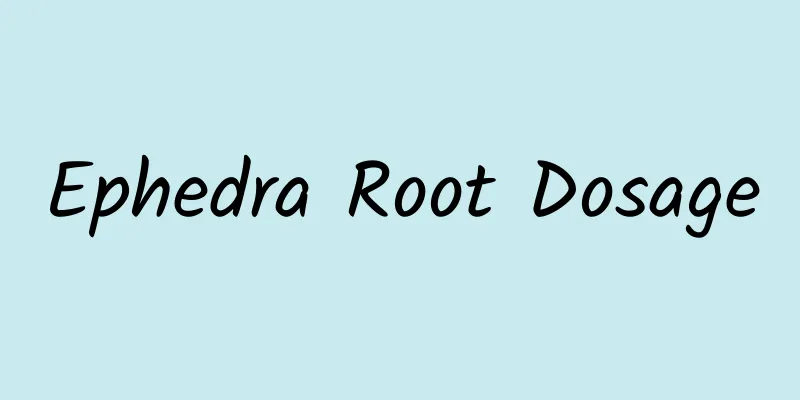Ephedra Root Dosage

|
Ephedra root is a traditional Chinese medicinal material. Its main function is to treat sweating caused by excessive coldness in the body. Ephedra root is the root of the ephedra plant. It and ephedra are two medicinal herbs with opposite effects. You must pay attention to the difference when selecting and using them. Ephedra is cylindrical in shape, with a rough skin that is reddish brown or grayish brown. When using ephedra root, generally about 3-9 grams is taken internally, and an appropriate amount can be used externally. Ephedra root benefits [Effects and characteristics] This product has a strong antiperspirant effect and can be used for all kinds of spontaneous sweating, but it must be used according to different conditions. If spontaneous sweating occurs due to deficiency of the exterior, use Qi-tonifying medicine; if white sweating occurs due to deficiency of yang, use Yang-tonifying medicine; if night sweating occurs due to deficiency of yin, use Yin-nourishing and astringent medicine; if postpartum sweating occurs, use blood-nourishing and surface-encircling medicine. Taking both the symptoms and the root cause into consideration, good results can be achieved. It can also be ground into a fine powder with calcined dragon bone and calcined oyster and applied externally to stop sweating. [Effects and Functions] Antiperspirant: ① Used for spontaneous sweating due to deficiency of the exterior, and can be used together with Astragalus, stir-fried white peony root, scorched Atractylodes macrocephala, etc. ② Used for spontaneous sweating due to yang deficiency, can be used together with ginseng and cinnamon twig. ③ Used for night sweats due to yin deficiency, it can be used together with Rehmannia glutinosa, Cornus officinalis, calcined dragon bone, and calcined oyster. ④ Used for postpartum sweating, it can be used together with blood-nourishing and exterior-strengthening drugs such as angelica and astragalus. [Identification and application] This product is the root of ephedra, which is a pungent and warm antipyretic drug with a stronger diaphoretic effect, while the root of ephedra is an antiperspirant. The two are the same thing but have different effects, and they are different roots and seedlings. They should not be confused when used. [Application of Combinations] Floating wheat and ephedra root are sweet and mild to stop sweating. Floating wheat is sweet and cool to stop sweating. Ephedra root enters the lung meridian, and "the lung is connected to the skin and hair", so it can stop sweating on the surface; floating wheat enters the heart meridian, and "sweat is the fluid of the heart", so it can invigorate qi and clear heat, cool the heart and stop sweating. Because floating wheat has a light constitution and its nature is ascending, it can reach the skin and expel the heat, so it can also stop night sweats. The two medicines are used together to promote each other, replenish qi and nourish the heart, clear away heat and cool the qi, consolidate the exterior and stop sweating. The combination of the two can indeed stop sweating. If used with Schisandra chinensis, Ophiopogon japonicus and Codonopsis pilosula, the therapeutic effect may be better. [Precautions for use] This product is specifically used to stop sweating and should not be used by those with external pathogens. [Usage and Dosage] Oral administration: 3-9 grams, used as decoction. For external use: Take appropriate amount and grind it into powder together with other medicines for external application. Identification of the properties of Ephedra root 1. Properties of the medicinal material: This product is cylindrical, slightly curved, 8 to 25 cm long, and 0.5 to 1.5 cm in diameter. The surface is reddish brown or grayish brown, with longitudinal wrinkles and root marks. The outer skin is rough and easily peels off in flakes. The rhizome has nodes, the internodes are 0.7 to 2 cm long, and there are long and horizontal protruding lenticels on the surface. It is light, hard and brittle, with yellowish-white bark in cross section, light yellow or yellow wood, radial rays and pith in the center. It has a faint smell and a slightly bitter taste. 2. Properties of the medicinal material: This product is in the form of thick round slices. The outer surface is reddish brown or grayish brown, with longitudinal wrinkles and root marks. The cross section of the bark is yellowish white, the wood is light yellow or yellow, fibrous, with radial patterns, and some have pith in the center. It has a faint smell and a slightly bitter taste. |
<<: The Difference Between Ephedra Root and Ephedra
Recommend
What are the effects and functions of deer grass?
Deer tongue grass is one of the Chinese medicinal...
The efficacy and function of three bitter leaves
The nutritional value of Sanya Kuye is rich and t...
Po Sum On Oil Benefits and Functions
What are the benefits of Po Sum On Oil? Po Sum On...
Technology News丨my country's first photovoltaic energy storage demonstration experimental platform is put into operation
【Today’s cover】 On November 19, a partial lunar e...
The efficacy and function of sheep lung
Diseases require improvement through medicine. Di...
New research: Once this core organ ages, the functions of the whole body will "regress"
The liver is an important detoxification organ in...
The efficacy and function of pear leaves
In daily life, people are not only very familiar ...
Scientific introduction of sandy watermelons has created an oasis in the desert
As we all know, the environmental conditions of a...
The benefits of decoction of Chinese medicine
Physical illness is something that we cannot avoi...
Will drinking edamame cause bone deformation? These things are the culprit
There was a news recently: An old man liked to ea...
If you lean on people, they will run away. If you lean on trees, they will fall down. What about if you lean on the wall?
As the old saying goes, If you rely on people, th...
KCI: 2023Q4 Consumer Survey Report
According to a survey by Kearney Consumer Researc...
What are the effects of drinking Chuanxiong soaked in water?
Chuanxiong is a rhizome of traditional Chinese me...
100 light years away, a "perfect solar system" was discovered
Author: Duan Yuechu Your browser does not support...
What is the difference between cornus officinalis and cornus officinalis?
Cornus officinalis is a medicinal material with m...









